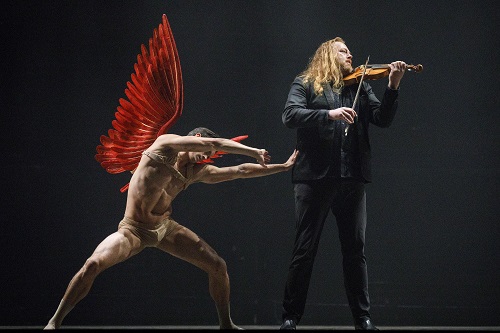
Opera Atelier is continuing its recent trend of pushing the boundaries of historically-informed early music performance practice by uniting staid, Baroque song and dance with sinuous contemporary ballet and music commissions in The Angel Speaks. The venue for this show was experimental as well, taking place in the Samuel Hall Currelly Gallery in the Royal Ontario Museum.
The performance weaves together 17th century music by Henry Purcell and William Boyce with contemporary compositions for period instruments by Edwin Huizinga. Huizinga’s music is influenced by Purcell and Boyce, but distinctly apart from it, creating very unique contrasts for the listener. The music was paired with Baroque choreography by co-Artistic Director Jeannette Lajeunesse-Zingg and contemporary dance by Tyler Gledhill, an artist of the Opera Atelier ballet. While related in their elegance and lyricism, the choreographic styles created a sharp visual contrast for viewer that mirrored the aural contrast.
The program opened with Music for a While by Purcell, a tempting opener for concerts for obvious thematic reasons. In my view though, this was unfortunately the weakest piece on the program. The tempo lagged below the acceptable lower limit for a marking of “andante”, resulting in singing that sounded laborious for baritone Jesse Blumberg and audible squeaks from the strings. There were also moments where the ensemble between instruments and singer was not as tight as I would expect from the seasoned professionals of the Tafelmusik Baroque Orchestra, most notably during the passage that returns us to the A section of aria.
Despite this inauspicious beginning, the rest of the program was a triumph. Soprano Mireille Asselin and Jesse Blumberg sparkled in their performance of “See Nature Rejoicing” from Purcell’s canonical “Come Ye Sons of Art”. Asselin was also spectacular in her performance of “The Blessed Virgin’s Expostulation”. Her repeated cries of “Gabriel” were haunting and emotive. Continuing the theme of contrast, her execution of the lengthy concert aria’s intricate melismatic passages was equally emotive and deft.
Tyler Gledhill’s contemporary dance choreography and performance was superb during Huizinga’s contemporary pieces. I was heartily impressed by his sinuous flexibility and impeccable muscular control as he lithely filled the long passage of the gallery space, which blended seamlessly with Huizinga’s exquisite music.
The Currelly Gallery brought advantages and disadvantages for the performance. There was something both sacrosanct and symbolic about seeing this piece under the lofty, vaulted ceiling of the gallery, surrounded by antiquities and modern day masterpieces . The creation of seating in the round brought a very intimate feel to the performance and left a long and ample space for musicians and dancers to fill. And fill it they did with the glittering, intricate costumes for which Opera Atelier is known and singers ably taking part in some of the dance numbers. On the other hand, the space was clearly not designed for musical performance and did not offer the performers some of the acoustic camouflage that a music venue typically would. And of course the close proximity of the seating to the performance space allowed us to hear the dancers landings, which disrupted the floating effect created by their taut, muscular control.
Despite some of the blemishes that are inherent in an experiment, I hope Opera Atelier keeps developing performances like The Angel Speaks. The piece cunningly reveals the unbroken thread from past to present, creating a highly engaging exposure to tradition and innovation. The “meet-the-artists” reception that followed with cash bar and refreshments by Daniel et Daniel was also a classy and welcome opportunity to mingle. All in all an excellent addition to their usual two-production season. I look forward to an event like this in the 2019/2020 season.
Details:
- The Angel Speaks played on February 21, 2019 at Samuel Hall Currelly Gallery in the Royal Ontario Museum (100 Queen’s Park, Toronto, Ontario)
- Show time was 8:00 PM on February 21.
- Ticket price $69 plus taxes and fees.
- Tickets were available online.
Photo of Tyler Gledhill and Edwin Huizinga by Bruce Zinger
